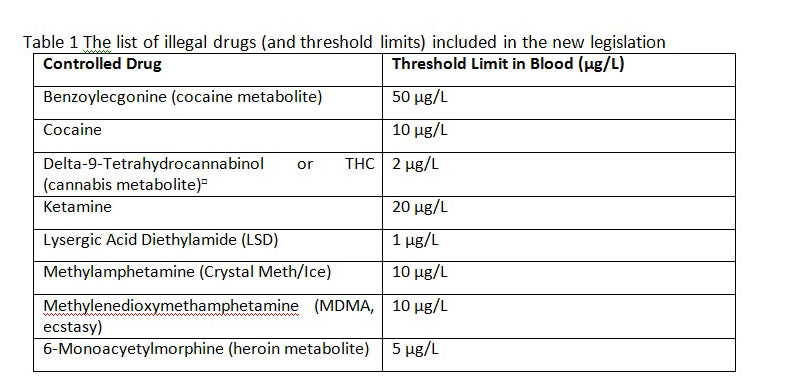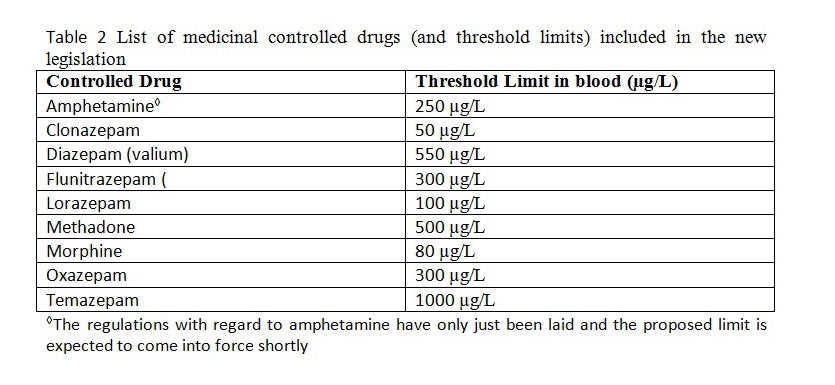 On Monday 2 March, the new drug driving legislation came into force in the UK taking on board many of the recommendations from the expert panel report commissioned by the Department for Transport published in March 2013 [1]. The new legislation specifies 16 controlled drugs and, in each case, the limit in blood for the purposes of the strict liability offence, detailed in section 5A of the Road Traffic Act 1988). The focus on “psychoactive” drugs has meant that excluded from the legislation are the drugs in Schedule 4 Part 2 (anabolic steroids) and over-the-counter medications (codeine based products). The legislation deals broadly with two groups of controlled drug: those which are illegal as shown in Table 1 and those which are available as prescription-only medicines (see Table 2).
On Monday 2 March, the new drug driving legislation came into force in the UK taking on board many of the recommendations from the expert panel report commissioned by the Department for Transport published in March 2013 [1]. The new legislation specifies 16 controlled drugs and, in each case, the limit in blood for the purposes of the strict liability offence, detailed in section 5A of the Road Traffic Act 1988). The focus on “psychoactive” drugs has meant that excluded from the legislation are the drugs in Schedule 4 Part 2 (anabolic steroids) and over-the-counter medications (codeine based products). The legislation deals broadly with two groups of controlled drug: those which are illegal as shown in Table 1 and those which are available as prescription-only medicines (see Table 2).
Illicit drugs
The illicit drugs included in the new legislation are those found in the UK driving population. The 2011/12 Crime Survey for England and Wales (CSEW) estimated that 8.9 percent of adults aged 16 to 59 had used illicit drugs in the last year (almost three million people), and that 3.0 percent had used a Class A drug in the last year (around a million people). For those who reported driving under the influence of illegal drugs at least once or twice in the last 12 months, cannabis and cocaine were the most commonly used drugs during this time period. Ninety percent reported using cannabis, and 51% reported using cocaine, in the last 12 months. MDMA, ketamine, LSD, methylamphetamine, and amphetamine use was also reported [2].
The illegal drugs have low thresholds (so called zero-tolerance) and therefore use of any kind is not compatible with driving and should be avoided. It will remain an offence, as now, to drive whilst driving is impaired by drugs; and, if in doubt, drivers should not drive.
The legislation is concerned with confirmatory tests: that is a blood sample to be undertaken in the police station, although to aid police authorities, road-side drug-screening devices have been approved to detect cannabis (THC (delta-9-tetrahydrocannabinol or Δ9- tetrahydrocannabinol) [3] and cocaine, two of the drugs most commonly found in UK drug-drivers
Medicinal controlled drugs
The second group consists of mainly licensed medicines that have a significant liability to be abused, and for which the specified limits have been set at a higher level than the first group (Table 2). The thresholds are based on road-safety-risk: specifically the risk of an injurious or fatal road traffic collision (RTC) in drug-drivers compared to non-drug-drivers.
The new legislation does not interfere with or alter the way in which drivers with medical conditions are treated at present. The DVLA’s “At a Glance” Guide to the Current Medical Standards of Fitness to Drive summarises the national medical guidelines of fitness to drive and is publically available on their website [4].
The higher limits are generally above the normal therapeutic range so most patients are unlikely to be driving with a concentration of a specified drug in their body above the specified limit. However, those on particularly high doses, for example, could test above the specified limit and would still be entitled to raise the statutory “medical defence” [5]. In relation to morphine, for example, the threshold is significantly above the average concentrations of morphine in blood found in cancer patients receiving long term steady-state doses of morphine [6]. The statutory “medical defence” can be raised by patients taking medicines in accordance with instructions, from either of these two groups.
Kim Wolff is the chair of the Department for Transport Expert Drug-Driving Report, King’s College London.
Competing interests: I declare that I have read and understood the BMJ policy on declaration of interests and I hereby declare that as chair of the drug-driving panel I received an honorarium for this work and have no additional conflicting interests.
References:
1. Expert Panel on drug-driving: Department for Transport (April 2012 – March 2013)
2. Drug Misuse Declared: Findings from the 2011/12 Crime Survey for England and Wales (2nd Edition)
3. Wolff K, Johnston A. Cannabis use: a perspective in relation to the forthcoming UK drug driving legislation. Drug Test Analysis. Invited review. published online: 11 DEC 2013, DOI: 10.1002/dta.1588
4. Berkowitz BA, Ngai SH, Yang JC, Hempstead J, Spector S, The disposition of morphine in surgical patients; Clinical Pharmacology and Therapeutics, 1975, vol. 17: pp. 629.
5. www.dft.gov.uk/dvla/medical/ataglance.aspx
6. https://www.gov.uk/government/uploads/system/uploads/attachmentdata/file/325275/healthcare-profs-drug-driving.pdf


